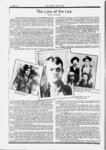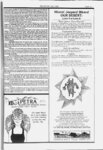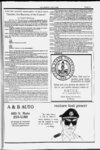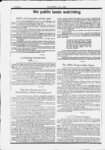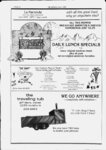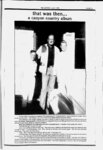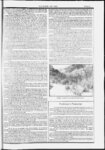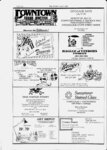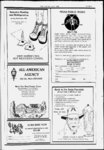| OCR Text |
Show PAGE 22 THE ZEPHYR JULY 1990 the public lands watchdog BLMs photographer permit plan If the Bureau of Land Management has Its way, any serious photographer who to be able to publish a photograph commercially, will be required to pay a $300 hopes annual fee to the BLM for the right to photograph on public lands. According to Mary von Koch of the BLM Area Office, the agency Is awaiting a final from Jack McDonald, BLM State Office Appraiser. If McDonald gives the decision the rule will soon go Into effect "(The permit) provides advantages to both parties, said von Koch. "We have a mechanism for authorizing people to be out there. And when people utilize public lands to make a living, there should be a return to the government But how will the BLM enforce such a rule? Photographs taken before the rules Into effect will be exempt, and many professional photographers, such as Moabs Tom goes Till and Steve Mulligan, have literally thousands of transparencies In their Inventories. How will the BLM be able to determine when the picture was taken? "We're going to give It our best shot, said von Koch. "We need to have an avenue... a starting point Other questions come to mind. Will artists be required to obtain a permit as well? Or writers? or photo Journalists? Does It make sense to create a new set of regulations that are so hopelessly unenforceable? Will the establishment of a new department be required to monitor the photographers and to force compliance? One final comparison. When the BLM chained 400 acres on Amasas Back In April, the ultimate "return to the government" In Animal Unit Months (AUMs) will be about $80. But It will cost $300 to photograph the devastation. Anyone wanting to comment on this proposal should contact: Brad Palmer. Grand 3. Resource Area Office. Sand Rats Road. Moab. Utah 84532 go-ahe- tollettype restrooms with running water and electricity. Currently the park provides a water truck (albeit of questionable quality) and has recently Installed new brick and adobe vault toilets at a cost of several thousand dollars. The park would have to run 14,000 feet of electrical line from the power source, a 40KW diesel generator, to the at Arches, the maintenance staff continually campground. (Author's note: As an grappled with electrical problems at Devito Garden which also depended on a diesel generator as Its power source. One of the problems frequently cited was the generator's distance from the use area less than one mile). At the Needles, the power source will be more than 2 miles from Squaw Flat The cost of bringing water and electricity to Squaw Flat and constructing two restrooms exceeds $700,000. Finally, all these projects, as well as trallhead Improvements at Elephant Hill, Cave Springs and Big Springs, will cause In some cases significant disruption of the environment The Park Service seems to contradict Itself when It describes how It will deal with these Impacts. The EA states: Install flush ad, 259-819- ex-ran- ger desert coupled with In relatively results slow regeneration extremely permanent scars from human Impact and associated development This characteristic suggests that It Is preferable to take care In design and construction and avoid disturbing vegetation rather than attempting to revegetate. "The fragile character of the high Yet when the NPS describes how It will deal with land disturbed by construction, "revegetation" Is relied upon time again to solve the problem. This contradiction deserves serious by park planners who must determine If the destruction of park resources resources the park to mandated to protect to worth the added luxuries these proposals will provide. The park to soliciting comments from the public until July 21. Write to Harvev Wlckware. Superintendent Canyonlands National Park. 125 W. 200 So. Moab. Utah 84532. re-thln- -- Jim Stiles a chaining moratorium, but -- Jim moratorium on Last month the Bureau of Land Management declared a one-ye- ar er In and sage lands Utah. The decision came following widespread chaining plnyon-Junlpof a 400 acre chaining operation near Moab In April (See condemnation and opposition BLM The conceded that changes In public attitudes toward land Zephyr. May 1990). Its policy. management have forced the agency to However, It appears that other forms of "land treatment will continue to receive consideration. The BLM has recently proposed a 2000 acre Tebuthluron treatment In the East Coyote cattle allotment, operated by Max Wilcox. According to Dave Williams of the BLM, Tebuthluron Is a herblcldal pellet that Is usually broadcast from a plane or helicopter over a proposed area. If the concentration Is strong enough, the poison will kill all vegetation Including trees; In milder concentrations, It will mostly target deep rooted shrubs, particularly sage. Once the natural cover Is eliminated, the area Is seeded with grasses to make the land more productive for grazing. At this time, the project Is In Its early stages; an environmental assessment has not yet been written. Persons Interested In participating In the process should contact Brad Palmer at the BLM Area Resource Office The project Is Identified as: East and Is located In T30SR25E and T29SR24E. Coyote Tebuthluron Treatment, re-eval- (259-819- 3). UT-068-- 90, -- Jim Stiles The Park Service EA for Dollar Development Multi-Millio- n Canyonlands National Park has released Its environmental assessment for proposed construction at the Needles District It Is soliciting public comment until July 21. The project, which carries an $11,400,000 price tag, will be completed In three phases and Includes the construction of a visitor center, entrance station, new housing and maintenance facilities, as well as a variety of road and utilities Improvements. While hardly anyone will disagree that a permanent visitor center Is needed to replace the current trallercontact station (the more sentimental of us will miss It anyway), other aspects of this proposal are certain to raise questions. The Park Service wants to build a new employee residence area, a mile northeast of the present housing area, and at a cost close to $2,000,000. In Its environmental assessment (EA), the NPS Justifies the new housing proposal, saying that the trailers used now are "undersized for family use, and explains that their proximity to the Maintenance area Is not an appropriate environment for family living quarters. The fact Is, the Needles District will never be suitable for "family living because It Is 55 miles from the nearest school In Monticello. There Is no school bus service available, and In fact, there has not been a family with school age children assigned to the Needles District In at least ten years--may- be longer. The Park Service will generally make an effort to assign unmarried rangers, or childless couples to that duty station solely because of the school situation. The EA states that the trailers "are aging rapidly, requiring constant maintenance, and are difficult to heatcool. Actually, three of the trailers are brand new, and three of the trailers are bath doublewldes more than spacious enough should a family ever work there. The construction cost of single-fami- ly residences Is estimated at $725,000. If there are no "families to live In them, why are they being built? Does the Park Service have a reliable and safe water supply to provide the needs of Increased usage? The Cave Springs well, which Is proposed for development, can consistently produce 60 gallons per minute, but according to the EA, "water quality from the Cave Springs well has not met secondary contaminant levels prescribed by the Utah drinking water standards. Aeration and reverse osmosis processes would be required to Improve water quality. According to a former employee, Needles employees will not drink the same water that to provided campers (via a water truck) "because of high alkali content Almost 15 years ago the NPS spent a small fortune on a deep well at the Hans Flat RangerResktonce area which serves the Maze District of Canyonlands. That water eventually proved to be unsafe even for bathing, and now all water to hauled to Hans Flat (a distance of over 150 miles) by truck. Can the NPS be sure that history wont repeat Itself? The Park Service proposes to "develop the Squaw Flat campground and plans to three-bedroo- m2 Stiles The NPSs Project Safe Check The National Park Service has Initiated a program called Project SAFE (Security Audit Fee Evaluation) Check. According to an Internal memorandum, "Project SAFE Check Is a series of unannounced audits of park fee collection operations and Imprest funds conducted by Regional Office Staff. Its purpose Is to heighten the awareness of park managers to Internal controls and to deter theft. The way the operation works Is this: While a fee collection ranger Is away from his or her duty station on a coffee or lunch break, the Project SAFE Check crew "will stock up the funds with extra money and wait to see If parks report being over In funds. This, according to Canyonlands Chief Ranger Tony Schetzsle who adds, "All they are doing Is trying to make It easy to be honest The memo discusses Investigations of Shortages and states "Last year we had a one hundred dollar theft of fee monies from one of the parks In the region. Is this the extent of known criminal activity by Park Rangers? I spoke to Ranger Activities Specialist Jim Reilly of the Regional Office who explained that a major theft at a park on the east coast led to Project SAFE Check, but conceded that thievery within the Rocky Mountain Region appeared minimal at this time. The Region sends out a team of 3 to 5 persons at a time to make unannounced audits. According to Reilly, Youre doing an employee a disservice when you don't look over their shoulder to some degree to make sure everythings right Because If they feel too free, they're going to take money. I asked Reilly If he thought this project would cost more than the amount of Illegally confiscated fee money recovered. He replied, Oh, yeah. We dont really know what kind of problem we have. There have been problems popping up now that weve taken more of an Interest In It... What's the driving part of this Is that with the S & L crisis, the big emphasis Is on Internal controls and management controls. I mean we're talking fairly small numbers here. If the people out there who are operating the booths think someone Is watching them, they're less likely to take money. Hurt's the bottom line. In an agency not generally known for outright graft and corruption, I asked Reilly If he thought this project was creating a heightened sense of paranoia among employees. His reply: "We want a certain level of paranoia out there. Citizens Interested In commenting on Project SAFE Check should write to: Lorraine Mlntzmever, Rocky Mountain Regional Office. 12795 W. Alameda Parkway. P. Q. Box 25287. Denver. CO 80225-028- 7. -- Jim G of G Stiles Theatre Gpdate The U of U Theater Project discussed In this column last month has now become the Kokopelll National Theater of the Arts. Both the name and the physical facilities continue to expand. The following Items are from a draft proposal that appeared In my mailbox a couple of weeks ago. The Sllckrock Bike Trail area to now going to be "enhanced with 1) an outdoor 2) a theater of the sky for astronomy presentations, 3) year-rouenclosed stage, and 4) a "concert shell. Also Included are a theater storage area, an arboretum development (to beautify the area It to rather bleak up there), educational chamber?), more propcostumerehearsal chambers, and finally, to really give the place some class, a REFLECTING POOL At least theyre going to do tills thing up right After all, without some Improvements like a reflecting pool, who would want to go to such a drab' desolate place nothing but sand and rock, cactus and Juniper, wind and clouds, potholes and unknown critters. But add some handrails and guided nature walks and a person could almost feel comfortable out there. Even though the upcoming Environmental Assessment to supposed to addrm whether this to an appropriate area for this project, I did notice that the first performance to scheduled for this coming October. This first event would probably be staged In one of the natural amphitheaters and would probably not Involve any construction. This would be theater-ln-the-rou- nd, nd |

















